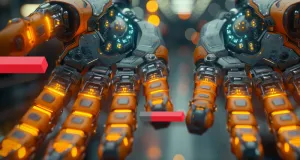Description:- Dive into our latest episode: “Solving Real-world Challenges: Unveiling the Truth – Manufacturing Customers Aren’t Buying AI, They’re Investing in Solutions.” Technology is changing the world as we know it and the question is - what does it mean for manufacturing business? We’re bringing you all the hard facts with two of our best experts in the field. Don’t miss this enlightening discussion! Tune in now on Tech Lyceum.
Guest Speaker:

Praveen Kumar Chougule
Senior Client Partner, Manufacturing
Transcripts
One thing we might all wonder about every day is, what is new in tech today? There are innovations happening every second. You know, upgrades on the daily, and it's a world that has propelled us forward at a pace we never imagined before, right? This is where we uncover what that means in the business context. Hi everyone. I'm Neerja, and this, of course, is tech lyceum. Today's conversation is all about solving real world challenges, unveiling the truth manufacturing customers aren't buying AI. They're investing in solutions. What does that mean for business to get to the bottom of it, we've got two experts. First, let me introduce our tech Lyceum veteran, and now I can even say a custodian of the show, Paul Menig, a thought leader and a senior business consultant at birlasoft manufacturing BBU. He's joining us on this episode, and Paul, as you know, has vast experience across various industries, including manufacturing, medical, defense, aerospace and transportation. Paul, it's good to have you back. How are you today?
Listen On

Speaker - Paul – 01:18
It's great to be here and have a chance to talk with everyone again.
It's great to be here and have a chance to talk with everyone again.
Speaker - Neerja - 1:22
Yes, it's fantastic to have you, and we can't wait to dive in. And joining Paul in this discussion is Praveen Chougule, senior client partner manufacturing, a veteran in his own right, in technology and sales, with over 20 years of experience, he has held senior roles like senior sales director, regional senior director and Global Service Delivery Manager. Praveen excels at building client relationships, you know, managing account portfolios and driving sales of digital and AI solutions across industries like manufacturing, aerospace, healthcare and retail. Praveen, it is your first time here. What are you hoping our listeners take away from this? Are you excited?
Yes, it's fantastic to have you, and we can't wait to dive in. And joining Paul in this discussion is Praveen Chougule, senior client partner manufacturing, a veteran in his own right, in technology and sales, with over 20 years of experience, he has held senior roles like senior sales director, regional senior director and Global Service Delivery Manager. Praveen excels at building client relationships, you know, managing account portfolios and driving sales of digital and AI solutions across industries like manufacturing, aerospace, healthcare and retail. Praveen, it is your first time here. What are you hoping our listeners take away from this? Are you excited?
Speaker - Praveen - 02:06
I'm absolutely excited. And first of all, thank you for having me. I really feel, I genuinely believe, that you're currently experiencing paradigm shift in the manufacturing industry, and I'm really fascinated by how AI is shaping. So I'm here to share my insights.
I'm absolutely excited. And first of all, thank you for having me. I really feel, I genuinely believe, that you're currently experiencing paradigm shift in the manufacturing industry, and I'm really fascinated by how AI is shaping. So I'm here to share my insights.
Speaker – Neerja –02:19
That sounds great. And on that note, let's get started. And Praveen, I'm going to pose the first question to you all right, Q: What are some of the most significant challenges currently faced by the manufacturing industry that AI can help address? And what would be great is if you could outline some examples of how AI driven solutions have been implemented to solve specific problems in manufacturing?
That sounds great. And on that note, let's get started. And Praveen, I'm going to pose the first question to you all right, Q: What are some of the most significant challenges currently faced by the manufacturing industry that AI can help address? And what would be great is if you could outline some examples of how AI driven solutions have been implemented to solve specific problems in manufacturing?
Speaker - Praveen -02:46
Well, it's quite intriguing question when it comes to manufacturing, ensuring shop floor safety and optimized operations is a major challenge, which I've seen with my customer base. Manufacturers are increasingly deploying Cobots for managing such a hazardous operation, complex quality inspection, which is improving the overall productivity. End to end supply chain, visibility is also crucial. They are embracing digitalization, leveraging big data analytics with AI to gain visibility beyond traditional tiers, building resilient and responsive supply chain. Third is predictive maintenance is a key for improved throughput. I have seen AI based MES systems are helping manufacturers detect anomalies and predict maintenance cycle in sustained way, improving uptime and throughput. And lastly, in today's competitor market, the customer experience is a critical differentiator. Leveraging AI, you could bring critical insights across product, engineering, manufacturing, sales and after market space. Close the title, customer experience, which drives the innovation based on customer sentiment. Remember, global AI in manufacturing market is projected to reach around 21 billion by 2028. At birlasoft we develop numerous solutions to forecast and to bring visibility of actual performance across product planning, engineering, supply chain, quality management, leveraging our engineers platform called Cogito.
Well, it's quite intriguing question when it comes to manufacturing, ensuring shop floor safety and optimized operations is a major challenge, which I've seen with my customer base. Manufacturers are increasingly deploying Cobots for managing such a hazardous operation, complex quality inspection, which is improving the overall productivity. End to end supply chain, visibility is also crucial. They are embracing digitalization, leveraging big data analytics with AI to gain visibility beyond traditional tiers, building resilient and responsive supply chain. Third is predictive maintenance is a key for improved throughput. I have seen AI based MES systems are helping manufacturers detect anomalies and predict maintenance cycle in sustained way, improving uptime and throughput. And lastly, in today's competitor market, the customer experience is a critical differentiator. Leveraging AI, you could bring critical insights across product, engineering, manufacturing, sales and after market space. Close the title, customer experience, which drives the innovation based on customer sentiment. Remember, global AI in manufacturing market is projected to reach around 21 billion by 2028. At birlasoft we develop numerous solutions to forecast and to bring visibility of actual performance across product planning, engineering, supply chain, quality management, leveraging our engineers platform called Cogito.
Speaker – Neerja- 04:14
Thanks Praveen, those are some hard hitting statistics and Paul, Q:Let me bring you in here to address some common misconceptions about AI in manufacturing, and also for you to give us your expert opinion on how to tackle them.
Thanks Praveen, those are some hard hitting statistics and Paul, Q:Let me bring you in here to address some common misconceptions about AI in manufacturing, and also for you to give us your expert opinion on how to tackle them.
Speaker – Paul- 04:29
That's an interesting set of questions. Neerja, AI is not magic. Guy named Alan Turing developed a test for machine intelligence in 1950 and the term artificial intelligence was used in 1956 when the first neural network was developed. In 97, a computer beat a human at chess, but thanks to an exhaustive brute force look at all the options at each stage that brute force approach is evident in the work since 2023 when generative artificial intelligence was introduced to the public, artificial intelligence is a computer somehow doing things humans used to do. Now, when you consider that, visual inspection, predictive diagnostics, and robotic manipulations are part of the continuum of artificial intelligence that we have been using in manufacturing for decades. If you ask your smartphone for a company's video showing how to repair a machine, you are using another form of AI called natural language processing. Young people are used to playing video games that get harder as they get better, the video game is using reinforcement learning. Large language models can be asked to draw charts and create Programmable Logic Controller software. How do you use it? Do not be afraid of AI. You're already using it. Play with it and learn to use it effectively.
That's an interesting set of questions. Neerja, AI is not magic. Guy named Alan Turing developed a test for machine intelligence in 1950 and the term artificial intelligence was used in 1956 when the first neural network was developed. In 97, a computer beat a human at chess, but thanks to an exhaustive brute force look at all the options at each stage that brute force approach is evident in the work since 2023 when generative artificial intelligence was introduced to the public, artificial intelligence is a computer somehow doing things humans used to do. Now, when you consider that, visual inspection, predictive diagnostics, and robotic manipulations are part of the continuum of artificial intelligence that we have been using in manufacturing for decades. If you ask your smartphone for a company's video showing how to repair a machine, you are using another form of AI called natural language processing. Young people are used to playing video games that get harder as they get better, the video game is using reinforcement learning. Large language models can be asked to draw charts and create Programmable Logic Controller software. How do you use it? Do not be afraid of AI. You're already using it. Play with it and learn to use it effectively.
Speaker -Neerja –06:07
Thanks, Paul. You also gave us an interesting history lesson right at the beginning and brought it back home with you know, the present-day scenario. Of course, we do integrate AI in so many aspects of our lives. And I'll follow that up with another question for you, Q:What steps should a manufacturing company take to successfully integrate AI solutions into their existing systems? And just how important is it for companies to have a clear understanding of their problem before seeking AI solutions?
Thanks, Paul. You also gave us an interesting history lesson right at the beginning and brought it back home with you know, the present-day scenario. Of course, we do integrate AI in so many aspects of our lives. And I'll follow that up with another question for you, Q:What steps should a manufacturing company take to successfully integrate AI solutions into their existing systems? And just how important is it for companies to have a clear understanding of their problem before seeking AI solutions?
Speaker - Paul - 06:35
Thanks, Neerja, first, AI is a tool for solutions, not a solution. The starting point is problems, pain points, quality issues, throughput issues. Figure out what is hampering your key performance indicators by doing process flow charts, Value Stream mappings, addressing the seven wastes, Six Sigma experiments, Fishbone diagrams, FMEAs and asking five whys, then prioritize what needs to be done first, with the biggest payback then and only then. Do you look at what tools should be used to solve the problem? AI of all sorts can be considered to start, I would be inclined to prompt a large language model with something like, what are the best tools and methods for solving a quality problem due to bearings seizing say on a Tommy carwash motor controlling a car wash conveyor line with a chain link drive provide links to manuals that would be my prompt to the AI. Fact that was my fourth attempt at such a prompt, and the answer I found was satisfying to me. In fact, the seven techniques I mentioned earlier in this section were from a prompt to a generative large language model, AI tool. I hope you can better understand that AI is another powerful tool in helping you solve the right problems in manufacturing.
Thanks, Neerja, first, AI is a tool for solutions, not a solution. The starting point is problems, pain points, quality issues, throughput issues. Figure out what is hampering your key performance indicators by doing process flow charts, Value Stream mappings, addressing the seven wastes, Six Sigma experiments, Fishbone diagrams, FMEAs and asking five whys, then prioritize what needs to be done first, with the biggest payback then and only then. Do you look at what tools should be used to solve the problem? AI of all sorts can be considered to start, I would be inclined to prompt a large language model with something like, what are the best tools and methods for solving a quality problem due to bearings seizing say on a Tommy carwash motor controlling a car wash conveyor line with a chain link drive provide links to manuals that would be my prompt to the AI. Fact that was my fourth attempt at such a prompt, and the answer I found was satisfying to me. In fact, the seven techniques I mentioned earlier in this section were from a prompt to a generative large language model, AI tool. I hope you can better understand that AI is another powerful tool in helping you solve the right problems in manufacturing.
Speaker – Neerja- 08:16
Yeah, well, put Paul and Praveen, Q: I'll ask you to come in here and round this up for us with perhaps a success story that you've seen where a manufacturing company effectively invested in an AI solution and saw measurable results. And also, if you could add to that, what some of the initial hurdles these companies faced and how they were overcome coming over to you?
Yeah, well, put Paul and Praveen, Q: I'll ask you to come in here and round this up for us with perhaps a success story that you've seen where a manufacturing company effectively invested in an AI solution and saw measurable results. And also, if you could add to that, what some of the initial hurdles these companies faced and how they were overcome coming over to you?
Speaker -Praveen - 08:37
Yeah, no, absolutely, very, great question. And in fact, at birlasoft we recently developed a truck movement monitoring for one of the largest wood product manufacturer where we developed a digital twin solution that replicates field operations and logistics. A single dashboard application was developed, showcasing KPIs and real time operations while enhancing reporting for multiple data attributes. We also did a what if simulation predict and prevent bottlenecks. This solution helped our customers provide real time alerts on delays, empowering process improvement and optimizing field operations on top the future logistic strategies are getting derived based on the real time data. So it's very interesting aspect, and you ask for the hurdles? Well, there are typical IT challenges where, you know, integrating with different legacy systems, ensuring data quality security, or major concern, which we address with effective solution strategy and data governance mechanism. However, as Paul said, it has to be business driven aspect. That's where you know, in my view, the business mindset change was most critical involving employees early, communicating benefits and addressing concern transparently, help effective change management and adopting this solution across stakeholders.
Yeah, no, absolutely, very, great question. And in fact, at birlasoft we recently developed a truck movement monitoring for one of the largest wood product manufacturer where we developed a digital twin solution that replicates field operations and logistics. A single dashboard application was developed, showcasing KPIs and real time operations while enhancing reporting for multiple data attributes. We also did a what if simulation predict and prevent bottlenecks. This solution helped our customers provide real time alerts on delays, empowering process improvement and optimizing field operations on top the future logistic strategies are getting derived based on the real time data. So it's very interesting aspect, and you ask for the hurdles? Well, there are typical IT challenges where, you know, integrating with different legacy systems, ensuring data quality security, or major concern, which we address with effective solution strategy and data governance mechanism. However, as Paul said, it has to be business driven aspect. That's where you know, in my view, the business mindset change was most critical involving employees early, communicating benefits and addressing concern transparently, help effective change management and adopting this solution across stakeholders.
Speaker- Neerja –09:58
Thank you, Praveen for taking us. That and Praveen Paul, at the start of the conversation, we said we would be unveiling the truth, right? And I think that's exactly what you've done. Q: Could I ask both of you to leave listeners with a thought or a takeaway from what we've just spoken about? Praveen, if you'd like to start us off,
Thank you, Praveen for taking us. That and Praveen Paul, at the start of the conversation, we said we would be unveiling the truth, right? And I think that's exactly what you've done. Q: Could I ask both of you to leave listeners with a thought or a takeaway from what we've just spoken about? Praveen, if you'd like to start us off,
Speaker - Praveen -10:17
I think you know, basically, let's not try to solve everything with it. Let's, let's understand what is the contextual as to business needs, look at what are the challenges, what customer needs, and then try to impose the technology aspects to solve that. I think that's, that's the way to go, in my view,
I think you know, basically, let's not try to solve everything with it. Let's, let's understand what is the contextual as to business needs, look at what are the challenges, what customer needs, and then try to impose the technology aspects to solve that. I think that's, that's the way to go, in my view,
Speaker -Neerja –10:34
a very fair point there. And Paul your thoughts,
a very fair point there. And Paul your thoughts,
Speaker - Paul – 10:37
as an engineer, I was trained to do certain things, and I can be the kind of person that, if I have a hammer, every problem looks like a hammer is the right tool to use. Don't get into that trap with AI. Focus on your business problems, first decide what they are, and then choose the right tool. And I will admit often AI will be one of the right tools to use to help solve the problem.
as an engineer, I was trained to do certain things, and I can be the kind of person that, if I have a hammer, every problem looks like a hammer is the right tool to use. Don't get into that trap with AI. Focus on your business problems, first decide what they are, and then choose the right tool. And I will admit often AI will be one of the right tools to use to help solve the problem.
Speaker – Neerja- 11:05
All this food for thought. I am sure everyone listening in has taken something away from this conversation. Thank you so much for being here with us.
All this food for thought. I am sure everyone listening in has taken something away from this conversation. Thank you so much for being here with us.
Speaker- Praveen & Paul – 11:13
Our pleasure. Neerja,
Our pleasure. Neerja,
Speaker – Neerja -11:22
Well, that is the wonderful world of tech Lyceum for you. My thanks to our guests for joining us and sharing their insights. There are many more episodes to come, so make sure to stay tuned to this space for more on tech. Bye.
Well, that is the wonderful world of tech Lyceum for you. My thanks to our guests for joining us and sharing their insights. There are many more episodes to come, so make sure to stay tuned to this space for more on tech. Bye.
You were listening to Tech Lyceum, a podcast from Birlasoft.
Other related Tech Lyceum episodes



